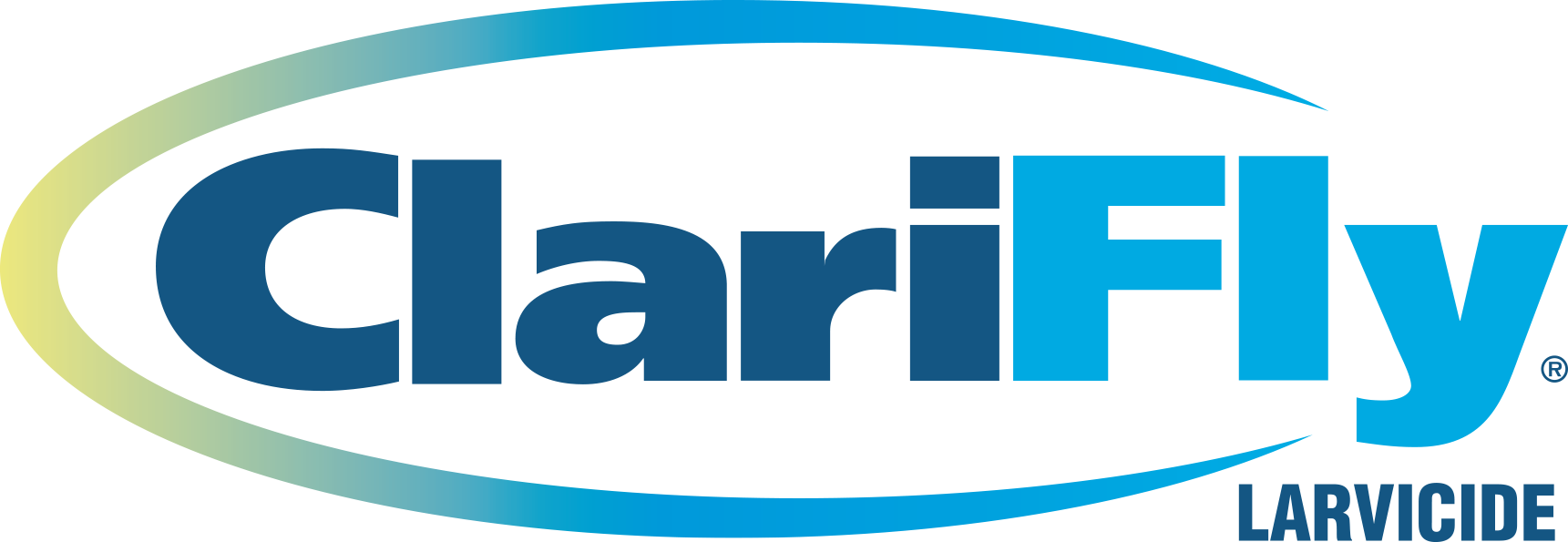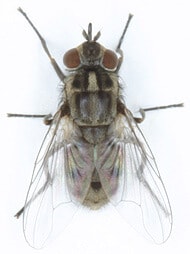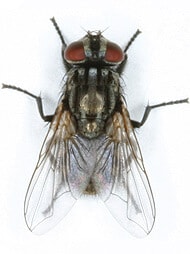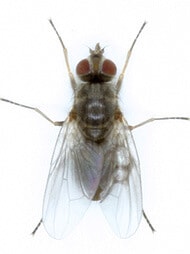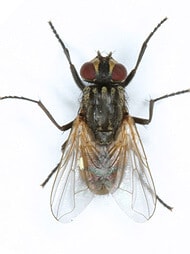STABLE FLY
STOMOXYS CALCITRANS
Stable Fly
The economic injury level for feeder cattle is when the stable fly population reaches an average of about five flies per front leg.1 In a compilation of studies, the five fly population groups showed a reduction in feed efficiency that resulted in an average loss of $8.51 per animal per season.2 At higher infestations, cattle demonstrated even greater reduction in average daily gains. The economic threshold is defined as the level of flies in which the economic loss is equal to the cost of controlling the pest. Additional evaluations indicated that the threshold would only be an average of 1.19 stable flies per front leg per animal.
Females lay hundreds of eggs in manure, wet hay and other decaying organic matter.
The stable fly is close in size to the house fly and has similar stripes on their thorax; however, stable flies have a distinct “checker-board” pattern on their abdomen. In addition to this, they have distinct piercing type mouthparts that are used to penetrate the skin of their hosts to obtain blood meals. Stable fly eggs are about 1 mm in length and are usually laid in masses of up to 50 eggs. Eggs hatch in 1 to 3 days.
Larvae prefer fecal material that has been mixed with soil, straw, bedding material, silage or grain, but will also develop in wet grass clippings, silage, and poorly managed compost piles. Like house fly larvae, stable fly larvae will migrate to drier areas to pupate.
Depending on the temperature, new adults will emerge for these pupae in 6 to 26 days. The entire life cycle takes 3 to 4 weeks.
1 McNeal & Campbell (©1981)2 John B. Campbell, The Economic Significance of the Stable Fly
FACE FLY
MUSCA AUTUMNALIS
Face Fly
Face flies resemble the house fly, but may be slightly larger and grayish in color. Face flies have 4 stripes on their thorax and sponging type mouthparts like the house fly. Females look very similar to the house fly, while male face flies have abdomens that are yellowish-orange in color. Female face flies lay eggs only on fresh, undisturbed cattle manure and are primarily considered a pastured cattle pest.
Larvae hatch from the eggs and feed under the dung crust. Once fully developed, the larvae disperse in surrounding soil to pupate. Adult face flies feed on secretions around the eyes, nose and mouth of cattle.
In the fall, newly emerged adults, stimulated by shortened days and cooler temperatures, go into diapause to delay reproduction until the following spring when temperatures are more favorable to survival of immatures. Often times, diapausing face fly adults are found in large numbers in attics of buildings and are referred to as cluster flies.
HORN FLY
HAEMATOBIA IRRITANS
Horn Fly
Implications are that total energy balance is altered when an animal is exposed to horn fly infestations, thereby resulting in decreased productivity.3
The economic threshold for horn fly infestation is defined as the number of horn flies per animal at which the value of the damage caused is equal to the cost of control.4
Horn flies are small biting flies about half the size of house and stable flies. They have piercing type mouthparts like the stable fly which they use to take up to 40 blood meals per day. They are grayish in color with two stripes on their thorax and are usually found congregating on the backs of cattle, only leaving to lay eggs in freshly deposited cow pats. Eggs are reddish-brown that hatch and feed in the manure pat and pupate underneath or in the surrounding soil around the pat. Pupae are brown and require 6 to 8 days to pupate depending on environmental conditions.
3 Byford, R.L., Craig, M.E., Crosby, B.L., A Review of Ectoparasites and Their Effect on Cattle Production, J. Anim. Sci., 1992, 70:597-602.
4 Mwangala, F.S., Galloway, T.D., 1993, Susceptibility of horn flies, Haematobia irritans (L.) (Diptera: Muscidae) to pyrethroids in Manitoba, Can., Entomol. 125: 47-53.
HOUSE FLY
MUSCA DOMESTICA
House Fly
House flies are non-metallic, dull grayish colored flies, approximately 6 - 7 mm in length with 4 distinct stripes on their thorax. The abdomen of the house fly is usually a pale color with yellowish sides and underside. Female house flies lay 1 mm long, slightly curved, whitish colored eggs that are normally deposited in batches of approximately 150 eggs in animal manure, wet organic matter, spilled feed, compost piles, decaying fruit and various other potential larval development areas.
The larvae of the house fly hatch within 24 hours, are white in color and feed on waste. The larvae will grow and eventually migrate away from the food source to drier areas to pupate. Pupae are dark brown.
The pupal stage will last anywhere from 3 to 10 days depending on temperature. Adults emerge from the puparium and begin feeding within 24 hours with sponging type mouthparts and the life cycle is repeated.
